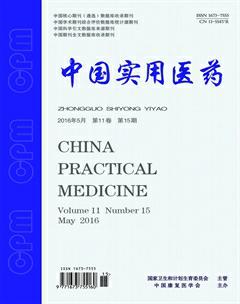心源性脑栓塞急性期抗栓治疗
毕敏+马琪林
【摘要】 了解心源性脑栓塞(CCE)急性期抗栓治疗的进展。回顾性分析近几年有关CCE急性期抗栓治疗的临床研究显示, 阿司匹林可应用于所有脑梗死急性期(包括CCE);CCE急性期使用肝素类抗凝剂弊大于利;对伴有心房颤动(AF)的脑梗死患者, 推荐使用华法林抗凝, 但何时为最佳给药点尚缺乏足够证据。CCE急性期抗栓治疗中阿司匹林疗效肯定, 华法林抗凝治疗亦有效, 但何时启用尚未达成共识。
【关键词】 心源性脑栓塞;房颤;急性期;抗凝;抗血小板聚集
DOI:10.14163/j.cnki.11-5547/r.2016.15.209
【Abstract】 Progress of antithrombotic therapy for acute stage of cardiogenic cerebral embolism (CCE) was comprehended. A retrospective analysis was made on clinical research of antithrombotic therapy for acute stage of CCE in recent years, and that showed aspirin is suitable for all acute stage of cerebral infarction (including CCE). Heparin anticoagulants provided more disadvantage than advantage for acute stage of CCE. Warfarin anticoagulation was recommended for cerebral infarction complicated with atrial fibrillation (AF) patients, while there was no sufficient evidence of the preferred medication time. Aspirin and Warfarin show effectiveness in anticoagulation for acute stage of CCE, while medication time needs discussion.
【Key words】 Cardiogenic cerebral embolism; Atrial fibrillation; Acute stage; Anticoagulation; Anti-platelet aggregation
脑血管疾病是危及人类健康的三大疾病之一[1], 而CCE占急性脑梗死的15%~25%。CCE的临床特点是起病急, 迅速达到高峰, 神经功能损害重, 脑梗死后出血转化率高, 而出血转化可进一步加重病情, 延长患者的住院和康复时间, 导致致残率和死亡率的增加。CCE中的栓子来源于各种病因导致的心脏内附壁血栓和赘生物, 常见的原因有AF(非瓣膜性和瓣膜性)、心肌梗死、人工瓣膜、急性或亚急性细菌性心内膜炎。本文就伴有AF的CCE急性期抗栓治疗做以下概述。现报告如下。
1 抗凝治疗
在心脏内附壁血栓形成的病理过程中, 凝血级联的激活比血小板的活化更重要[2], 所以抗栓治疗中的抗凝治疗从理论上讲能够阻断这一过程, 应是一种很有希望的治疗手段。更有资料称抗凝治疗可以改善红细胞变形能力、改善侧支循环、促进血管再通, 利于缺血半暗带供血而起到挽救缺血半暗带、减轻脑组织损伤、改善神经功能缺损的作用, 改善预后、提高生活质量、降低死亡率及致残率[1, 3]。
目前CCE的抗凝治疗中AF及心肌梗死引起的左心室附壁血栓分别获得美国心脏协会治疗指南的Ⅰ级推荐A级证据及Ⅱa推荐B级证据[4]。已经证实, 对于有短暂性脑缺血发作(TIA)或脑卒中病史者, 口服抗凝治疗作为AF患者脑卒中的二级预防, 能够减少脑梗死发生率的50%~60%[5]。
新近的临床试验发现合并AF的脑梗死患者2周内的梗死再发率为5%~8%, 每天的风险大概为0.1%~1.3%[6], 可看出CCE患者急性期再发脑梗死的风险较高, 因此该疾病的早期二级预防也应得到相应的重视。
同时, CCE的自发出血转变率较高, CT研究描述了这种变化为13%~43%, 而临床对照研究报告出血转化率为3.2%~37%[7]。已知可增加CCE出血转化的因素包括高龄、血压、是否使用抗凝剂及梗死面积大小等, 因此抗凝治疗在CCE急性期应用的安全性和有效性则仍存在争议。
1. 1 肝素及低分子肝素 至今, 国内外已有很多临床研究对伴有AF的脑梗死患者进行了急性期静脉抗凝治疗。脑动脉栓塞研究(CESG)是一个小样本临床对照研究, 分为肝素组(24例)和阿司匹林组(21例)。研究发现[8], 阿司匹林组有2例并发梗死后出血, 2例发生早期再栓塞, 而肝素组无一例出现上述两种情况。此项研究发表后引发了一个CCE急性期抗凝治疗的风潮, 但这项研究样本量偏小, 仅入组45例, 不能因此得出有统计学意义的结论。随后, 又有TAIST(tinzaparin in acute ischemic)[9]和TOAST(trial of ORG 10172 in acute stroke treatment)[10] 两项研究分别将低分子肝素和阿司匹林进行了对照研究。TAIST研究发现, 低分子肝素对CCE早期二级预防(7~14 d)并不优于阿司匹林, 并且增加了出血并发症的发生率, 也不改变6个月时患者的死亡率和依赖程度, 但TAIST研究中AF患者仅占12%, TOAST研究中比例更低, 仅为8%, 因此这样的结果在CCE的研究中仍然没有显著的统计学意义[10, 11]。
Camerlingo等[12, 13]对一组发病3 h内急性脑梗死患者行低分子肝素治疗, 其中41.3%的患者伴有AF, 结果提示在早期神经功能恢复及死亡率方面, 低分子肝素疗效优于生理盐水, 但肝素组的梗死后症状性出血转化率明显增高。
国际中风试验(IST)(18451例)是一项大样本、多中心、随机双盲的临床研究[14]。该研究对比分析了阿司匹林、肝素、两者联用及两者缺如在脑梗死急性期及非急性期的疗效。其中伴有AF的急性缺血性脑卒中的研究结果发表于2001年[15]。
伴有AF的脑梗死患者随机分配接受肝素12500 IU、肝素5000 IU及无肝素治疗, 其发生脑梗死后出血几率为2.8%、1.3%、0.4% (P<0.05);再发脑梗死的几率为2.3%, 3.4%, 4.9% (P=0.001<0.05);任何类型脑卒中或死亡事件发生率为18.8%、 19.4% 及 20.7%, (P=0.3>0.05)。因此, 尽管肝素组在脑梗死复发率上有所降低, 但这种优势被增加的症状性脑出血所抵消, 以致死亡率及6个月神经功能评分没有显著差异, 故不提倡在AF合并的脑梗死急性期广泛应用肝素或低分子肝素。
1. 2 维生素K拮抗剂 维生素K拮抗剂——华法林在治疗深静脉血栓及预防肺栓塞和脑卒中方面疗效肯定, 但在有关CCE急性期治疗的大部分研究中尚未获得肯定结论。
2008年Hallevi等[16]发表了一项有关CCE急性期抗栓治疗的回顾性研究(204例), 旨在比较CCE急性期应用华法林(35例)、阿司匹林(88例)、肝素桥接华法林(44例)及低分子肝素桥接华法林(29例)抗栓治疗和非治疗组(8例)患者的疗效与症状性出血发生率。研究提示, 接受华法林或肝素/低分子肝素桥接华法林治疗的患者发生再栓或脑卒中进展几率低于未接受抗凝治疗组12.5倍, 但低分子肝素桥接华法林治疗组发生了3例症状性颅内出血, 肝素桥接华法林治疗组发生了2例系统性出血。该研究提示在CCE急性期抗栓治疗应用华法林是相对安全的, 但在急性期肝素/低分子肝素桥接华法林治疗可能会增加出血风险。
1. 3 新型抗凝剂 与华法林相比, 新型抗凝剂具有稳定的药代动力学特点, 治疗窗宽, 与食物、药物无相互作用, 无需监测凝血功能, 出血并发症更少。研究表明凝血酶直接抑制剂(DTI)和凝血因子Xa直接抑制剂是目前最具前途的新型抗凝剂。目前正在进行的AF抗栓治疗评价的新型抗凝药物包括达比加群(dabigatran)、利伐沙班(rivoroxaban) 和阿哌沙班(apixaban), 相应的研究有RE-LY实验[17, 18], ROCKET-AF实验[19]和ARISTOTLE实验等[20, 21]。上述研究得出的结论是:这些新型口服抗凝药在AF患者预防脑卒中或全身性栓塞方面不劣于华法林, 在降低颅内出血或系统性出血方面具有一定优势, 可作为华法林的安全替代药物。但目前这些研究均限于AF患者脑卒中预防, 而非急性期治疗, 未来有待于更多有关新型口服抗凝药用于脑梗死急性期的研究。
2 抗血小板聚集治疗
中国大型急性中风试验(CAST)是一项有关脑梗死急性期阿司匹林(160 mg, q.d.)疗效与安全性研究的大型随机、双盲、安慰剂对照试验, 共纳入21106例患者, 其中AF患者1411例[22]。IST研究的亚组分析, 也将伴有AF的脑梗死患者再次分为有阿司匹林组和无阿司匹林组[15]。Hart基于CAST和IST的研究做了一个回顾性分析, 结果提示阿司匹林一定程度上降低了AF患者再发栓塞的几率, 联合CT检查结果, 提示相对危险度减少30%, 脑梗死后出血率在两组间未见明显差异。
大约30%的AF患者可能由于其他非栓塞机制引起再发梗死。AF患者可能同时伴有动脉粥样硬化, 这样阿司匹在预防再发梗死的作用更可能是通过控制动脉粥样硬化血栓形成上起了作用[23]。
3 小结
CCE并发出血的危险性较大, 为了平衡抗凝和出血转化之间的关系, 急性期的抗栓治疗更应慎重。上述研究证据表明:除非存在绝对禁忌证, 阿司匹林可应用于所有脑梗死急性期(包括CCE);目前有充分证据证实CCE急性期使用肝素类抗凝剂弊大于利, 因而不推荐常规立即给予抗凝治疗;华法林是常用且有效的抗凝药物, 对伴有AF的脑梗死患者, 推荐使用华法林抗凝治疗, 但何时给予华法林最佳, 目前尚缺乏足够证据;新型抗凝剂是未来替代华法林的安全药品, 但目前研究仅限于AF患者卒中预防, 希望未来有更多有关新型抗凝药用于脑梗死急性期的研究。
参考文献
[1] Wolf PA, DAgostino RB, Belanger AJ, et al. Probability of stroke: a risk profile from the Framingham Study. Stroke, 1991, 22(3):312-318.
[2] Yasaka M, Yamaguchi T, Miyashita T, et al. Predisposing factors of recurrent embolization in cardiogenic cerebral embolism. Stroke, 1990, 21(7):1000-1007.
[3] Sporer B, Haberl RL. Low molecular weight heparin: immediate therapy of stroke? A discussion of the study by Kay et al.: Low molecular weight heparin for treatment of acute ischemic stroke. Nervenarzt, 1996, 67(10):886-887.
[4] Diener HC, Ringelstein EB, von Kummer R, et al. Treatment of acute ischemic stroke with the low-molecular-weight heparin certoparin: results of the TOPAS trial. Therapy of Patients With Acute Stroke (TOPAS) Investigators. Stroke, 2001, 32(1):22-29.
[5] Font MN, Krupinski J, Arboix A. Antithrombotic Medication for Cardioembolic Stroke Prevention. Stroke Research & Treatment, 2011, 2011(12):607852.
[6] Connolly S, Pogue J, Hart R, et al. Clopidogrel plus aspirin versus oral anticoagulation for atrial fibrillation in the Atrial fibrillation Clopidogrel Trial with Irbesartan for prevention of Vascular Events (ACTIVE W): a randomised controlled trial. Lancet, 2006, 367(9526):1903-1912.
[7] Kelley RE, Berger JR, Alter M, et al. Cerebral ischemia and atrial fibrillation: prospective study. Neurology, 1984, 34(10):1285-1291.
[8] Jaillard A, Cornu C, Durieux A, et al. Hemorrhagic transformation in acute ischemic stroke. The MAST-E study. MAST-E Group. Stroke, 1999, 30(7):1326-1332.
[9] Glick JA, Brophy GM. Prevention and treatment of cardioembolic stroke: a case study. Consult Pharm, 2009, 24(12):903-909.
[10] Bath PM, Lindenstrom E, Boysen G, et al. Tinzaparin in acute ischaemic stroke (TAIST): a randomised aspirin-controlled trial. Lancet, 2001, 358(9283):702-710.
[11] The Publications Committee for the Trial of ORG in Acute Stroke Treatment (TOAST) Investigators. Low molecular weight heparinoid, ORG 10172 (Danaparoid), and outcome after acute ischemic stroke: a randomized controlled trial. Journal of the American Medical Association, 1998, 279(16):1265-1272.
[12] Camerlingo M, Salvi P, Belloni G, et al. Intravenous heparin started within the first 3 hours after onset of symptoms as a treatment for acute nonlacunar hemispheric cerebral infarctions. Stroke, 2005, 36(11):2415-2420.
[13] Paciaroni M, Agnelli G, Micheli S, et al. Efficacy and safety of anticoagulant treatment in acute cardioembolic stroke: a meta-analysis of randomized controlled trials. Stroke, 2007, 38(2):423-430.
[14] Weber R, Weimar C, Diener HC. Medical prevention of stroke and stroke recurrence in patients with TIA and minor stroke. Expert Opin Pharmacother, 2009, 10(12):1883-1894.
[15] Saxena R, Lewis S, Berge E, et al. Risk of early death and recurrent stroke and effect of heparin in 3169 patients with acute ischemic stroke and atrial fibrillation in the International Stroke Trial. Stroke, 2001, 32(10):2333-2337.
[16] Hallevi H, Albright KC, Martin-Schild S, et al. Anticoagulation after cardioembolic stroke: to bridge or not to bridge? Arch Neurol, 2008, 65(9):1169-1173.
[17] Hylek EM, Held C, Alexander JH, et al. Major bleeding in patients with atrial fibrillation receiving apixaban or warfarin: The ARISTOTLE Trial (Apixaban for Reduction in Stroke and Other Thromboembolic Events in Atrial Fibrillation): Predictors, Characteristics, and Clinical Outcomes. J Am Coll Cardiol, 2014, 63(20):2141-2147.
[18] Goto S, Zhu J, Liu L, et al. Efficacy and safety of apixaban compared with warfarin for stroke prevention in patients with atrial fibrillation from East Asia: a subanalysis of the Apixaban for Reduction in Stroke and Other Thromboembolic Events in Atrial Fibrillation (ARISTOTLE) Trial. Am Heart J, 2014, 168(3):303-309.
[19] Johnston SC, Amarenco P, Albers GW, et al. Acute stroke or transient ischemic attack treated with aspirin or ticagrelor and patient outcomes (SOCRATES) trial: rationale and design. Int J Stroke, 2015, 10(8):1304-1308.
[20] Bogousslavsky J, Van Melle G, Regli F, et al. Pathogenesis of anterior circulation stroke in patients with nonvalvular atrial fibrillation: the Lausanne Stroke Registry. Neurology, 1990, 40(7):1046-1050.
[21] 刘欣, 秦明照. 心房颤动患者口服新型抗凝药的获益与风险. 心血管病学进展, 2013, 34(1):31-35.
[22] Diener HC, Connolly SJ, Ezekowitz MD, et al. Dabigatran compared with warfarin in patients with atrial fibrillation and previous transient ischaemic attack or stroke: a subgroup analysis of the RE-LY trial. Lancet Neurol, 2010, 9(12):1157-1163.
[23] Shanahan E, Keenan R, Cunningham N, et al. Acute stroke unit improves stroke management-four years on from INASC. Ir Med J, 2015, 108(2):51-53.
[收稿日期:2015-12-22]

